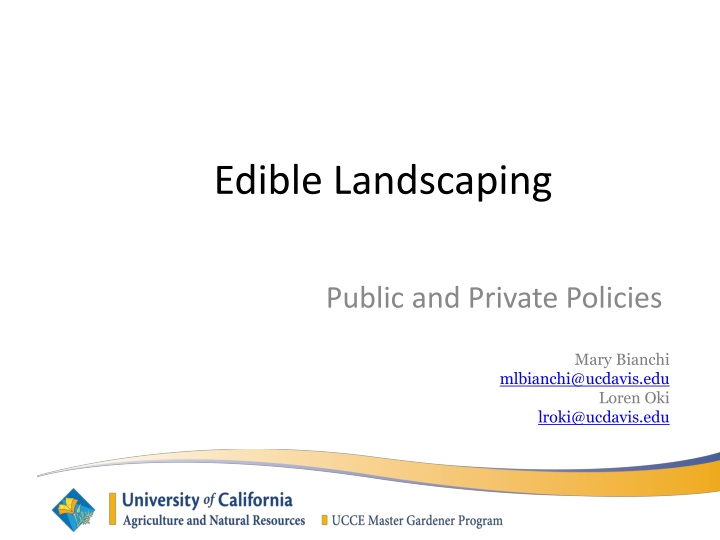
Land Use Policies and Restrictions for Edible Landscaping in Urban Areas
Explore the public and private policies governing edible landscaping, considering audience response tools, local community regulations, and restrictions on home gardening. Learn about land use policies that differentiate between edible and ornamental landscapes, along with insights into food safety considerations.
Download Presentation

Please find below an Image/Link to download the presentation.
The content on the website is provided AS IS for your information and personal use only. It may not be sold, licensed, or shared on other websites without obtaining consent from the author. If you encounter any issues during the download, it is possible that the publisher has removed the file from their server.
You are allowed to download the files provided on this website for personal or commercial use, subject to the condition that they are used lawfully. All files are the property of their respective owners.
The content on the website is provided AS IS for your information and personal use only. It may not be sold, licensed, or shared on other websites without obtaining consent from the author.
E N D
Presentation Transcript
Edible Landscaping Public and Private Policies Mary Bianchi mlbianchi@ucdavis.edu Loren Oki lroki@ucdavis.edu
Audience Response/Polling Tools Turning Technologies clickers
Have you used audience response tools before? A.Yes B.No C. Not sure 0% 0% 0% A. B. C.
Your Local Community Local Regulations or Policies Land Use Food Safety Water Use
Are your edible gardens restricted by Covenants Codes and Restrictions (CCRs)? 1. Yes 2. No 3. I am not sure 0% 0% 0% 1 2 3
Land Use Private policies/restrictions Home Owner Association Restrictive Covenants Covenants, Conditions, Restrictions (CCR) Fort Bend Texas no vegetable gardens shall be permitted except in fully screened areas in the backyard only so as not to be visible from the street or objectionable to an adjacent property Maintenance and aesthetics are key! (?) AB 1061, Lieu 2009 This act provides that the architectural guidelines of a common interest development shall not prohibit or include conditions that have the effect of prohibiting the use of low water-using plants as a group.
Land Use Public and private policies may differentiate based on edible versus ornamental landscapes e.g. Sacramento City ordinance required turf or low growing groundcover in front yards Section 17.68.010 of Title 17 Sacramento City Code (April 3, 2007) the remaining unpaved portion of the setback areas shall be landscaped, irrigated, and maintained. The landscape may include grass, annuals, perennials, ground cover, shrubs, trees
Land Use Public policies or restrictions Focus on community gardens Edible landscape policies might relate to Setbacks Height of vegetation in front and back yards Maintenance Restrictions on restrictive covenants May require specific plant materials (trees) for new development
Food Safety Policy Donating produce (e.g., to food banks) Organization or Institution policy Check with target organization Clean containers, sound product with minimum 3-day shelf life (typical) Government policy May be local guidance Department of Environmental Health Non-food safety policy may apply to preventing spread of pests (e.g., Light Brown Apple Moth, Asian Citrus Psyllid) Donations may be restricted to county in which product was grown and may need to be defect free (caterpillar damage)
If I am not sure how a policy applies to edible landscapes or food harvested from these landscapes, I should: A. Eat the food B. Don t eat the food C. Ask a UC Master Gardener D. Ask a UC CE Advisor E. Seek information from an appropriate agency 0% 0% 0% 0% 0% A. B. C. D. E.
Water Use Policies related to water use may address: Budget Allocation and Pricing Water Capture and Conservation Rainwater collection systems Greywater systems
MWELO (2015) Model Water Efficient Landscape Ordinance (MWELO) Applicable to: New residential and commercial development project with an aggregate landscape area equal to or greater than 500 sq.ft. requiring a building or landscape permit, plan check or design. Rehabilitated landscape project with an aggregate landscape area equal to or greater than 2,500 sq.ft. . requiring a building or landscape permit, plan check or design. Permit requires calculating an estimation of annual landscape water use
SLA is short for (Choose BEST Answer) A. Special Libraries Association B. Symbionese Liberation Army C. Science Leadership Academy D. Special Landscape Area E. Singapore Land Authority 0% 0% 0% 0% 0% A. B. C. D. E.
MWELO The estimated residential landscape water use must be less than or equal to 0.55 times ETo (reference ET). Areas of edible plants are classified as Special Landscape Areas (SLAs) SLAs are assigned an ETAF (ET Adjustment Factor) of 1.0
MWELO MAWA= Maximum Applied Water Allowance (gallons/year) Water budgets may not exceed MAWA Budgets calculated using plant water use information in WUCOLS Annual Estimated Water Use (ETo) Of Landscape 55% ETAF SLA
MWELO Budgets calculated using plant water use information in WUCOLS http://www.water.ca.gov/ wateruseefficiency/docs/ wucols00.pdf
MWELO Model Water Efficient Landscape Ordinance (MWELO) Local Ordinances in place of MWELO
I can find more information about landscape water use policies from: 1. Department of Water Resources 2. My water provider 3. County CE office 4. California Center for Urban Horticulture 5. All of the above 0% 0% 0% 0% 0% 1 2 3 4 5
Information about MWELO Local ordinances may exist in place of or in addition to MWELO Water provider City or county water resources department Department of Water Resources website http://www.water.ca.gov/ CalRecycle http://www.calrecycle.ca.gov/ Professional organizations (e.g., CLCA, APLD)
Thank you! Any Questions? Mary Bianchi mlbianchi@ucdavis.edu Loren Oki lroki@ucdavis.edu
